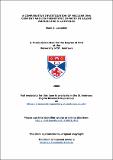Files in this item
A comparative investigation of nuclear DNA content and its phenotypic impacts in Silene marizii and S. latifolia
Item metadata
| dc.contributor.advisor | Meagher, Thomas Robert | |
| dc.contributor.author | Looseley, Mark E | |
| dc.coverage.spatial | ix, 137 p. | en |
| dc.date.accessioned | 2008-03-24T09:56:53Z | |
| dc.date.available | 2008-03-24T09:56:53Z | |
| dc.date.issued | 2008 | |
| dc.identifier | uk.bl.ethos.552092 | |
| dc.identifier.uri | https://hdl.handle.net/10023/455 | |
| dc.description.abstract | Considerable variation exists both within and between species in nuclear DNA content. Despite there being no obvious functional role for much of this DNA, many studies have reported phenotypic correlations with genome size at various taxonomic levels. This suggests that DNA plays a functional role beyond the traditionally understood mechanisms. One such example of a phenotypic correlation with DNA content is present in the genus Silene, where a negative correlation between DNA content and flower size exists within and between species. This relationship is consistent with the direction of sexual dimorphism in DNA content (caused by heteromorphic sex-chromosomes) and flower size in the most studied species in the genus: S. latifolia. This thesis takes a comparative approach between two closely related species in the genus (S. latifolia and S. marizii), which differ markedly in their nuclear DNA content, in order to investigate the nature and phenotypic impacts of variation in DNA content. A phenotypic survey from a number of S. marizii populations reveals that the pattern of DNA content variation in this species is very different to that in S. latifolia. In particular, phenotypic correlations with DNA content appear be much weaker, whilst sexual dimorphism in DNA content, when present, appears to occur in either direction. A survey of interspecific hybrids suggests that this may be due to an enlarged S. marizii X-chromosome and that DNA content in hybrids may be biased with regard to their parents. Repetitive elements may be significant constituents of plant genomes. A study of Ty1-copia class retrotransposons in the two species reveals that they are present as a large and highly heterogeneous population. Phylogenetic analysis of these elements suggests a substantial degree of genetic isolation between the two species. Finally, an assessment of the flow-cytometric method, used to estimate DNA content, reveals substantial error associated with the method, but only limited evidence for stoichiometric effects. | en |
| dc.format.extent | 1979666 bytes | |
| dc.format.mimetype | application/pdf | |
| dc.language.iso | en | en |
| dc.publisher | University of St Andrews | |
| dc.rights | Creative Commons Attribution-NonCommercial-NoDerivs 3.0 Unported | |
| dc.rights.uri | http://creativecommons.org/licenses/by-nc-nd/3.0/ | |
| dc.subject | DNA content | en |
| dc.subject | Genome size | en |
| dc.subject | Latifolia | en |
| dc.subject | Marizii | en |
| dc.subject | Silene | en |
| dc.subject | Retrotransposon | en |
| dc.subject | LTR | en |
| dc.subject | Flower size | en |
| dc.subject | Calyx diameter | en |
| dc.subject | Flow cytometry | en |
| dc.subject | Ty1- copia | en |
| dc.subject.lcc | QH447.L7 | |
| dc.subject.lcsh | DNA | en |
| dc.subject.lcsh | Genomes | en |
| dc.subject.lcsh | Silene | en |
| dc.subject.lcsh | Flow cytometry--Methodology | en |
| dc.title | A comparative investigation of nuclear DNA content and its phenotypic impacts in Silene marizii and S. latifolia | en |
| dc.type | Thesis | en |
| dc.contributor.sponsor | Natural Environment Research Council (NERC) | en |
| dc.contributor.sponsor | Beckman Coulter | en |
| dc.type.qualificationlevel | Doctoral | en |
| dc.type.qualificationname | PhD Doctor of Philosophy | en |
| dc.publisher.institution | The University of St Andrews | en |
This item appears in the following Collection(s)
Except where otherwise noted within the work, this item's licence for re-use is described as Creative Commons Attribution-NonCommercial-NoDerivs 3.0 Unported
Items in the St Andrews Research Repository are protected by copyright, with all rights reserved, unless otherwise indicated.


